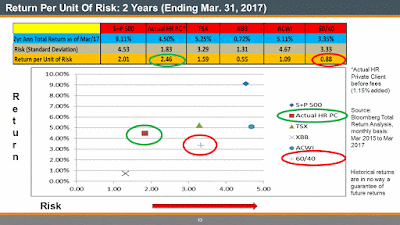After Fees, What's Left?
As we do each week in preparation for our (High Rock) weekly client webinar, we prepare a table of a combination of benchmark returns by blending the All Country World Index (ACWI) equity ETF and the Canadian Bond Universe (XBB) equity ETF for comparison purposes:
What stands out to me is that if you have a blended 60% equity (ACWI) and 40% fixed income (XBB), buy and hold balanced portfolio and are paying a fee of 1.15%, that over the last 2 years with a total return close to 4.5% (total return calculated on a daily basis to May 30, 2017, source: Bloomberg), you are netting only about 3 1/4%. Over 3 years, the same blended, balanced situation has captured only about 3 3/4%. That is pretty significant when you think about it.
2 or 3 years of lower than average returns which includes a 1 year return ( in the most recent year) of close to 10.5%, after fees!
The 5 year return has been a substantially better, 7 1/2%.
It means that volatility over the last 3 years has been pretty high and that the standard "buy and hold" philosophy has not been working because the correlations between stock and bond prices have not fulfilled their historical role.
When I first started writing these blogs back in 2015, one of my themes was that we were going to be in a low return environment for quite some time.
That is why, a couple of years ago, we (when we started the High Rock Private Client division) came up with an idea to add a third dimension to the standard "buy and hold" portfolio. One where we had to work a little harder to earn our fees, but one where we could add extra value that would help elevate returns, while at the same time, also helped to reduce risk (especially in times of higher volatility).
The point here is that volatility has not gone away, it is just dormant. When it re-appears, back to 2015 and 2016 levels (likely when central banks reduce the cushion of liquidity that has subdued recent volatility), portfolio returns (for the balanced blend) are going to continue to remain low and what we have experienced over the last 6 months will become an aberration.
So investing will require a better approach than the simple "buy and hold" methodology.
What you have to wonder is, what are you going to be paying fees for?






















